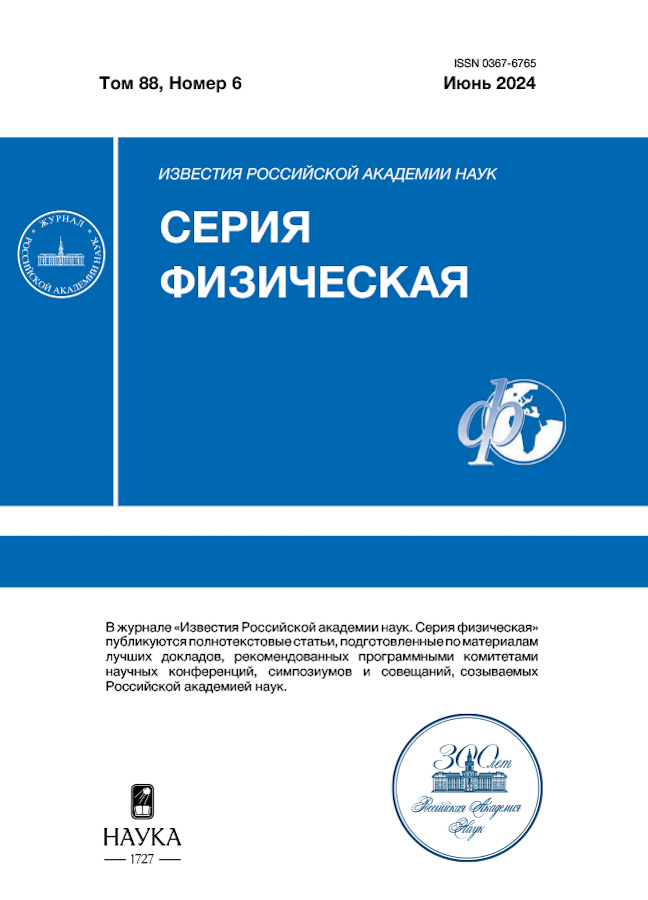Fluorescent research of antibiotic phototransformation in aqueous solution
- Autores: Bezlepkina N.P.1, Tchaikovskaya O.N.1,2, Bocharnikova E.N.1
-
Afiliações:
- National Research Tomsk State University
- Institute of Electrophysics of the Ural Branch of the Russian Academy of Sciences
- Edição: Volume 88, Nº 6 (2024)
- Páginas: 952-959
- Seção: Luminescence and Laser Physics
- URL: https://kld-journal.fedlab.ru/0367-6765/article/view/654664
- DOI: https://doi.org/10.31857/S0367676524060178
- EDN: https://elibrary.ru/PFVPWO
- ID: 654664
Citar
Texto integral
Resumo
We presented a spectral-luminescent study of the sulfaguanidine phototransformation in aqueous solution under the action of ultraviolet lamp OUVb-04 (180—275 nm), KrCl (222 nm), XeBr (282 nm) and XeCl (308 nm) excilamps. An analysis of the conversion of sulfaguanidine in water shows that, under the action of XeBr excilamp radiation, the efficiency of sulfaguanidine phototransformation in water is comparable to the decrease upon excitation of OUVb-04, but higher than upon irradiation with KrCl or XeCl excilamps. The maximum loss for sulfaguanidine is 99 % without the introduction of additional oxidizing agents. After irradiation, several photoproducts of various nature were recorded.
Palavras-chave
Texto integral
Sobre autores
N. Bezlepkina
National Research Tomsk State University
Autor responsável pela correspondência
Email: nadezhda.bezlepkina174833@mail.ru
Rússia, Tomsk
O. Tchaikovskaya
National Research Tomsk State University; Institute of Electrophysics of the Ural Branch of the Russian Academy of Sciences
Email: nadezhda.bezlepkina174833@mail.ru
Rússia, Tomsk; Yekaterinburg
E. Bocharnikova
National Research Tomsk State University
Email: nadezhda.bezlepkina174833@mail.ru
Rússia, Tomsk
Bibliografia
- Ионин А.А., Гончуков С.А., Зазымкина Д.А. и др. // Изв. РАН. Сер. физ. 2020. Т. 84. № 11. С. 1537; Ionin A.A., Gonchukov S.A., Zazymkina D.A. et al. // Bull. Russ. Acad. Sci. Phys. 2020. V. 84. No. 11. P. 1321.
- Daughton C.G., Ternes T.A. // Environ. Health Perspect. 1999. V. 107. P. 907.
- Ternes T.A., Meisenheimer M., McDowell D. et al. // Environ. Sci. Technol. 2002. V. 36. P. 3855.
- Khan M.F., Yu L., Hollman J. et al. // Environ. Sci. Water Res. Technol. 2020. V. 6. No. 6. P. 1711.
- Borowska E., Felis E., Miksch K. // J. Adv. Oxid. Technol. 2015. V. 18. No. 1. P. 69.
- Yi Z., Wang J., Tang Q., Jiang T. // RSC Advances. 2018. V. 8. No. 3. P. 1427.
- Lemanska-Malinowska N., Felis E., Surmacz-Górska J. // Arch. Environ. Prot. 2013. V. 39. No. 3. P. 79.
- Zhu G., Sun Q., Wang C. et al. // Int. J. Environ. Res. Public. Health. 2019. V. 16. No. 10. Art. No. 1797.
- Mersly L.E.L., Mouchtari E.M.E., Zefzoufi M. et al. // J. Photochem. Photobiol. A. 2022. V. 430. Art. No. 113985.
- Tchaikovskaya O.N., Bocharnikova E.N., Solomonov V.I. et al. // Bull. Russ. Acad. Sci. Phys. 2023. V. 87. Suppl. 2. P. S217.
- Семибратова В.А., Егранов А.В. // Изв. РАН. Сер. физ. 2019. Т. 83. № 3. С. 345; Semibratova V.A., Egranov A.V. // Bull. Russ. Acad. Sci. Phys. 2019. V. 83. No. 3. P. 287.
- Литвинов В.А., Коппе В.Т., Логачев Ю.Е., Бобков В.В. // Изв. РАН. Сер. физ. 2010. Т. 74. № 2. С. 203; Litvinov V.A., Koppe V.T., Logachev Y.E., Bobkov V.V. // Bull. Russ. Acad. Sci. Phys. 2010. V. 74. No. 2. P. 183.
- Burrows H.D., Canle L.M., Santaballa J.A., Steenken S. // J. Photochem. Photobiol. B. 2002. V. 67. No. 2. P. 71.
- Lin A.Y.C., Lin Y.C., Lee W.N. // Environ. Pollution. 2014. V. 187. P. 170.
- Tchaikovskaya O.N., Bocharnikova E.N., Bazyl O.K. et al. // Molecules. 2023. V. 28. No. 10. Art. No. 4159.
- Базыль О.К., Чайковская О.Н., Чайдонова В.С. и др. // Опт. и спектроск. 2022. Т. 130. № 5. С. 627; Bazyl O.K., Tchaikovskaya O.N., Chaydonova V.S. et al. // Opt. Spectrosc. 2022. V. 130. No. 5. P. 487.
- Phillips G.O., Power D.M., Sewart M.C. // Radiat. Res. 1973. V. 53. No. 2. P. 204.
- Numan A., Villemure J.L., Lockett K.K., Danielson N.D. // Microchem. J. 2002. V. 72. No. 2. P. 147.
- Sun J., Chen L., Zhang X. et al. // Food Chem. 2023. V. 424. Art. No. 136410.
- Wojnárovits L., Tóth T., Takács E. // Crit. Rev. Environ. Sci. Technol. 2018. V. 48. No. 6. P. 575.
- Jiang J., Wang G. // IOP Conf. Ser. Earth Environ. Sci. 2017. V. 100. Art. No. 012040.
- Безлепкина Н.П., Чайковская О.Н., Бочарникова Е.Н., Базыль О.К. // Опт. и спектроск. 2023. Т. 131. № 4. С. 543; Bezlepkina N.P., Tchaikovskaya O.N., Bocharnikova E.N., Bazyl' O.K. // Opt. Spectrosc. 2023. V. 131. No. 4. P. 508.
Arquivos suplementares














